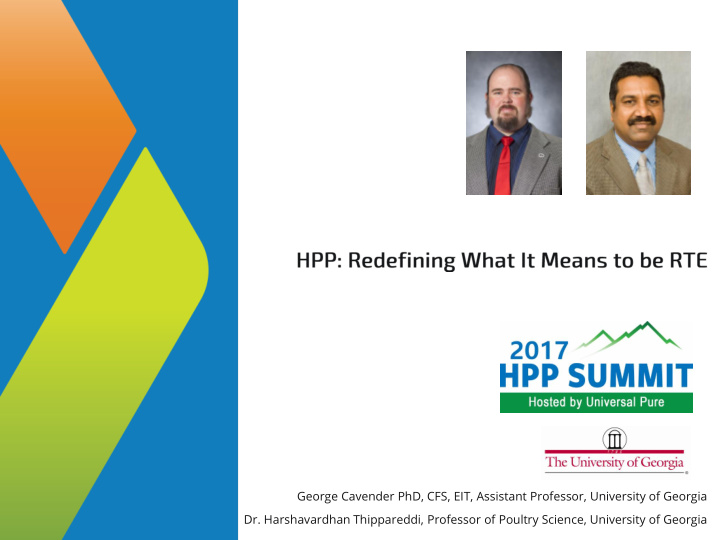



George Cavender PhD, CFS, EIT, Assistant Professor, University of Georgia Dr. Harshavardhan Thippareddi, Professor of Poultry Science, University of Georgia
▪ Brief overview of HPP ▪ Common uses ▪ Exciting developments
▪ Brief overview of HPP ▪ Common uses ▪ Exciting developments
▪ Processing foods using extreme pressures ▪ No official range, though 100-800 Mpa has been suggested by FDA ▪ Most commercial processed are performed in the 300-600 MPa range ▪ Also sometimes called “pascalization” or “High Hydrostatic Pressure” (HHP) ▪ Much older than you might think ▪ Used primarily as a safety measure
▪ Water as a working fluid ▪ Most foods processed in package ▪ Can disrupt non-covalent bonds, allowing it to: ▪ Denature proteins ▪ Inactivate enzymes ▪ Disrupt membranes ▪ Minimal thermal effect
▪ Control of Vibrio in seafood ▪ Also significantly aids in shelf-life and further processing ▪ Control of post-cook contamination in RTE meats ▪ “Cold Pasteurization” of juices and smoothies ▪ Limited use in dairy ▪ Smoothies ▪ “Raw Milk” (Made by Cow, AUS) ▪ Cow colostrum (Col+, NZ) ▪ Some research has shown possible benfits in fermented dairy products (milk, cheese, etc)
▪ Most work to date has dealt with pathogen control ▪ Even the processing benefits of HPP on seafood was something of a happy accident ▪ HPP can do so much more.
▪ “Fully cooked” or “safe to eat?” ▪ Many people from many cultures around the world prefer foods that are not cooked to a level experts consider safe.
N=106
We can use HPP to render undercooked foods safe. ▪ Recent example: Beef Steak ▪ HPP can reduce O157:H7 in rare steak by six logs ▪ https://doi.org/10.1016/j.lwt.2017.07.037 ▪ Resulting steak retains red color, similar texture ▪ Further cooking via immersion circulator ( sous vide ) showed little difference in behavior
▪ This tends to work better than processing Raw foods ▪ HPP effects changes in the myoglobin and other proteins, resulting in a “cooked appearance”
▪ This tends to work better than processing Raw foods ▪ HPP effects changes in the myoglobin and other proteins, resulting in a “cooked appearance”
▪ Altering Myoglobin state may help alleviate some color changes, but so far is not a silver bullet.
Control 600MPa/ 6min 600MPa/ 3min 450MPa/ 3min A: Deoxymyoglobin B: Oxymyoglobin C: Metmyoglobin D: Carboxymyoglobin
SN SN+E CJ CJ+CP SN-O SN+E-0 A: Control (No HPP) B: 600 MPa / 3 min. C: 600 MPa / 6 min. D: 450 MPa / 3 min.
▪ We can use HPP for improving quality as well as safety ▪ HPP is not a magic bullet, it has limitations ▪ Understanding the nature of the limitations can help to create ways to mitigate the limitations ▪ We can also think outside the box and create new and exciting products for which the limitations are strengths
Recommend
More recommend